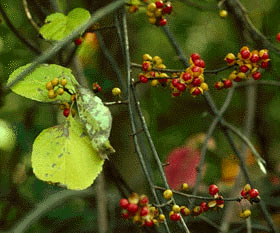Celastrus orbiculatus
| Chinese Bittersweet | |
|---|---|
 | |
| Binomial: | Celastrus orbiculatus |
| Type: | Woody vine |
| Conditions: | very adaptable |
| Seed Dispersal: | Birds |
| Ripe Seed: | Winter |
| Vegetative Spread: | rampant spreader and climber |
Celastrus orbiculatus, Chinese Bittersweet, Oriental Bittersweet, or Oriental Staff Vine is a twining woody vine native to East Asia, but naturalised in other parts of the world, and invasive in a large region of North America. The vine was introduced into North America in 1879, and has since become a damaging weed.
Description
editThe defining characteristic are the vines themselves. Young vines are thin spindly, with silver to reddish brown bark. Older vines become thick and trunk-like, with a somewhat shiny gray bark with prominent dots (lenticels). When growing without supports to climb it forms shrubby thickets, but more commonly is found growing over trees or shrubs climbing by twisting around the branches or trunks.[1] The encircling vines frequently girdle the supporting tree or branch.[1]
The leaves are round and glossy, 2–12 cm long, have toothed margins and grow in alternate patterns along the vines.[1] Small green flowers produce the distinctive red seeds. The seeds are encased in yellow pods that break open during autumn. All parts of the plant are poisonous.
Ecology
editBefore it was recognized as a destructive invasive species, Oriental staff vine was planted along roadsides to help control soil erosion.[2] The orange red berries and the vines that hold them are popular as holiday decorations.
Because of these uses, Oriental staff vine has taken over landscapes, roadsides, and woods. In the United States it can be found as far south as Virginia, as far north as New York, and as far west as the Rocky Mountains.[3] It prefers mesic woods, where it has been known to eclipse native plants.
Uses
editControl
editOriental staff vine has spread very quickly in the United States, and can be quite damaging to native plants and ecosystems. The easiest way to get rid of a small infestation is by ripping the plants out of the ground by their roots. If there is a large colony of them the recommended course of action is to cut at the root, and apply glyphosphate, as most herbicides have no effect on the vine.[3] The application of glyphosphate should be done at the beginning of winter.[3]
- Mowing: Mowing is effective if done frequently (this is not a lawn weed)
- Cultivation: Effective for young plants only, and needs to be repeated, as the plant can grow back from small rootlets.
- Mulching (for prevention): Not effective (seeds will germinate beneath mulch)
- Coppicing: Effective to prevent seed production only
- Grinding: Weakens the plant, but the outer roots will regrow
- Pulling: Best done in moist soil, as the roots are fragile, and severed roots will grow new plants
- Flame: effective as a burndown only
- Barriers: not effective, in fact barriers can protect the plant and make later attempts to pull more difficult
- Grazing: May be toxic to some livestock
- Disposal: Hot composting only.
References
edit- ↑ a b c Richard H. Uva, Joseph C. Neal and Joseph M. Ditomaso, Weeds of The Northeast, (Ithaca, NY: Cornell University Press, 1997), Pp. 336-337.
- ↑ Celastrus orbiculatus - Oriental Bittersweet Vine
- ↑ a b c Max Hutchison, VEGETATION MANAGEMENT GUIDELINE: Round-leaved bittersweet (Celastrus orbiculatus Thunb.)